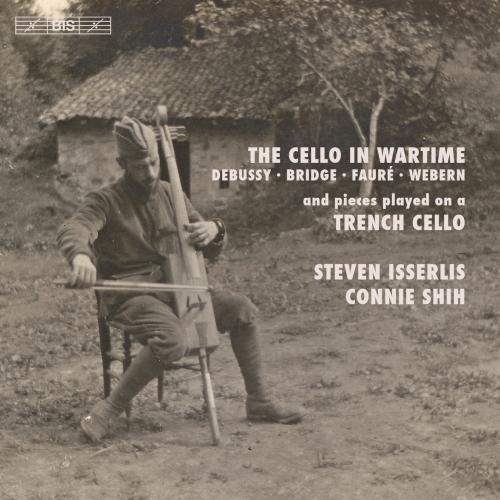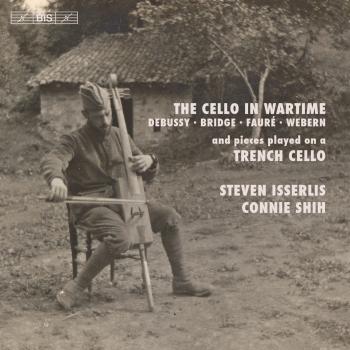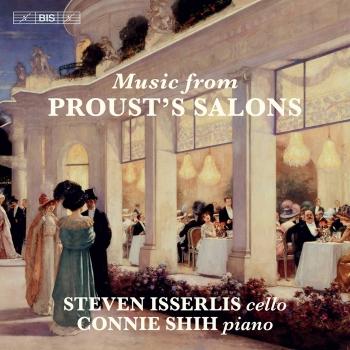
The Cello in Wartime Steven Isserlis & Connie Shih
Album info
Album-Release:
2017
HRA-Release:
03.11.2017
Album including Album cover Booklet (PDF)
- Claude Debussy (1862 - 1918): Cello Sonata in D Minor, L. 135:
- 1 I. Prologue 04:07
- 2 II. Serenade 02:59
- 3 III. Finale 03:22
- Frank Bridge (1879 - 1941): Cello Sonata:
- 4 I. Allegro ben moderato 10:35
- 5 II. Adagio ma non troppo - Molto allegro e agitato 12:26
- Gabriel Fauré (1845 - 1924): Cello Sonata No. 1 in D Minor, Op. 109:
- 6 I. Allegro 05:27
- 7 II. Andante 07:05
- 8 III. Finale. Allegro comodo 05:58
- Anton Webern (1883 - 1945): 3 Kleine Stücke, Op. 11:
- 9 No. 1, Mäßige Achtel 01:01
- 10 No. 2, Sehr bewegt 00:19
- 11 No. 3, Äußerst ruhig 01:29
- Camille Saint-Saëns (1835 - 1921): Carnival of the Animals, R. 125:
- 12 XIII. Le cygne (Version for Cello & Piano) 03:35
- Anonymous:
- 13 Jerusalem (Arr. for Cello & Piano) 02:19
- 14 Keep the Home Fires Burning (Arr. for Cello & Piano) 02:02
- 15 God Save the King (Arr. for Cello & Piano) 00:50
Info for The Cello in Wartime
Dieses Album ist eine Zeitreise – zurück in die Zeit des 1. Weltkriegs. Isserlis beginnt das Programm mit drei Sonaten, die in diesen Jahren komponiert wurden. Doch dann tauscht er seine »Marquis de Corberon«-Stradivari gegen ein Instrument, das einst in den Schützengräben vor Ypern gespielt und gehört wurde: ein sogenanntes Trench Cello.
Harold Triggs, der Besitzer des Instruments, brachte es aus Flandern nach England mit. Die Idee: Der Korpus ist zugleich die Schachtel, in der Griffbrett und Wirbel, Stachel und Steg sowie der Bogen transportiert werden können. Nach etwa fünfminütigem Aufbau wird so aus der Kiste ein spielbares Cello. Andere Soldaten bauten sich auf ähnliche Weise Geigen oder Flöten aus allem Material, das sie halt auf den Schlachtfeldern finden konnten.
Diese Instrumente legen so ein sehr bewegendes Zeugnis ab von der unstillbaren Suche der Menschen nach Schönheit und Freude, selbst auf diesen fürchterlichen Schlachtfeldern. Mit der einfühlsamen Unterstützung durch Connie Shih (selbst Klaviere fanden den Weg in die Schützengräben!) entführt uns Steven Isserlis auf ein Schlachtfeld nahe Ypern während einer kurzen Feuerpause zu Soldaten, die ausruhen, nach Hause schreiben oder Karten spielen und mit Hilfe der Musik von einem anderen Leben an anderem Ort träumen.
Steven Isserlis, Cello (on tracks 1-11), Trench Cello (on tracks 12-15)
Connie Shih, Klavier
Steven Isserlis
Acclaimed worldwide for his profound musicianship and technical mastery, British cellist Steven Isserlis enjoys a distinguished career as a soloist, chamber musician, educator, author and broadcaster.
As a concerto soloist he appears regularly with the world’s leading orchestras and conductors, recent engagements including performances with the Berlin Philharmonic, Budapest Festival, Philharmonia, Cleveland, Minnesota, Zurich Tonhalle and NHK Symphony Orchestras. He gives recitals every season in major musical centres, working with pianists such as Jeremy Denk, Kirill Gerstein, Stephen Hough, Alexander Melnikov, Olli Mustonen, Mikhail Pletnev, Sir Andras Schiff, Connie Shih, Ferenc Rados and Dénes Várjon; and plays with many of the world’s leading chamber orchestras, including period-instrument ensembles. Unusually, he also directs chamber orchestras from the cello, in classical programmes.
Highlights of the 15/16 season include a survey of the complete Bach Cello Suites at the Wigmore Hall and elsewhere; recital programmes with Ian Bostridge, Stephen Hough, Robert Levin and Richard Egarr; a special recital with Sir Andras Schiff at the Beethovenhaus in Bonn performed on fortepiano and Beethoven’s own cello (which was last played in public more than 50 years ago); his appointment as Guest Artistic Leader of the Norwegian Chamber Orchestra; a major European tour with the Academy of St Martin-in-the-Fields and Joshua Bell; and the world premiere of the orchestral version of Thomas Adès’s Lieux retrouvés in Lucerne, with the composer himself conducting.
As a chamber musician he has curated series for many of the world’s most famous festivals and venues, including the Wigmore Hall, the 92nd St Y in New York, and the festivals of Salzburg and Verbier. These specially devised programmes have included ‘In the Shadow of War’, a major four-part series for the Wigmore Hall to mark the centenary of the First World War and the 75th anniversary of the Second World War; explorations of Czech music; the teacher-pupil line of Saint-Saens, Faure and Ravel; the affinity of the cello and the human voice; varied aspects of Robert Schumann’s life and music; and the music of Serge Taneyev (teacher of Steven’s grandfather, Julius Isserlis). For these concerts Steven is joined by a regular group of friends who include the violinists Joshua Bell, Pamela Frank and Isabelle Faust, violist Tabea Zimmermann, and clarinettist Michael Collins.
He takes a strong interest in authentic performance, and in addition to working with many of the foremost period instrument orchestras he frequently gives recitals with harpsichord and fortepiano. Together with Robert Levin, and using original or replica pianos from the early nineteenth century, he has performed and recorded Beethoven’s complete music for cello and piano; and with Richard Egarr he has performed and recorded the viola da gamba sonatas of J.S. Bach as well as sonatas by Handel and Scarlatti.
He is also a keen exponent of contemporary music and has premiered many new works, including John Tavener’s The Protecting Veil (as well as several other pieces by Tavener), Thomas Adès’s Lieux retrouvés, Stephen Hough’s Sonata for Cello and Piano, Left Hand (Les Adieux), Wolfgang Rihm’s Concerto in One Movement, David Matthews’ Concerto in Azzurro, works for cello and piano by Olli Mustonen, and For Steven by György Kurtág.
Writing and playing for children is another major interest. Steven Isserlis’ books for children about the lives of the great composers – Why Beethoven Threw the Stew and its sequel, Why Handel Waggled his Wig – are published by Faber and Faber. He has also written the text for three musical stories for children – Little Red Violin, Goldiepegs and the Three Cellos and Cindercella – with music by Oscar-winning composer Anne Dudley; these are published by Universal Edition in Vienna. He has also given many concerts for children, for several years presenting a regular series at the 92nd Street Y in New York. As an educator Steven Isserlis gives frequent masterclasses all around the world, and for the past eighteen years he has been Artistic Director of the International Musicians’ Seminar at Prussia Cove in Cornwall, where his fellow-professors include Sir Andras Schiff, Thomas Adès and Ferenc Rados. As a writer and broadcaster he contributes regularly to publications including Gramophone, The Daily Telegraph and The Guardian, has guest edited The Strad magazine, and makes regular appearances on BBC Radio including on the Today programme, on Soul Music, as guest presenter of two editions of Saturday Classics, and as writer and presenter of a documentary about the life of Robert Schumann.
His diverse interests are reflected in an extensive and award-winning discography. His recording of the complete Solo Cello Suites by J.S. Bach for Hyperion met with the highest critical acclaim, and was Gramophone’s Instrumental Disc of the Year and Critic’s Choice at the Classical Brits. Other recent releases include Prokofiev and Shostakovich concertos with the Frankfurt Radio Symphony and Paavo Järvi; Dvorak Cello Concertos with the Mahler Chamber Orchestra and Daniel Harding; the complete works for cello by Beethoven with Robert Levin on fortepiano, selected for the Deutsche SchallplattenPreis; and recital discs with Richard Egarr, Stephen Hough, Thomas Adès and (for BIS) a Grammy-nominated album of sonatas by Martinů with Olli Mustonen. Future releases for Hyperion include the Elgar and Walton concertos, alongside works by Gustav and Imogen Holst, with the Philharmonia Orchestra and Paavo Järvi.
The recipient of many awards, Steven Isserlis’s honours include a CBE in recognition of his services to music, and the Schumann Prize of the City of Zwickau. He is also one of only two living cellists featured in Gramophone’s Hall of Fame.
He gives most of his concerts on the Marquis de Corberon (Nelsova) Stradivarius of 1726, kindly loaned to him by the Royal Academy of Music.
Connie Shih
The Canadian pianist, Connie Shih, is repeatedly considered to be one of Canada’s most outstanding artists. In 1993 she was awarded the Sylva Gelber Award for most outstanding classical artist under age 30. At the age of nine, she made her orchestral debut with Mendelssohn's first Piano Concerto with the Seattle Symphony Orchestra. At the age of 12, she was the youngest ever protégé of Gyorgy Sebok, and then continued her studies at the Curtis Institute in Philadelphia with Claude Frank, himself a protégé of Arthur Schnabel. Later studies were undertaken with Fou Tsong in Europe.
As soloist, she has appeared extensively with orchestras throughout Canada, the U.S.A. and Europe. In a solo recital setting, she has made countless appearances in Canada, the U.S., Iceland, England, Spain, Italy, Germany, Japan and China. Connie has given chamber music performances with many world-renowned musicians. To critical acclaim, she appears regularly in recital with cellist Steven Isserlis. Including chamber music appearances at the Wigmore and Carnegie Halls, she performs at the prestigious Bath Music Festival, Aldeburgh, Cheltenham, Weill Hall (N.Y.), and at the Kronberg Festival. Her collaborations have included Susan Gritton, Tabea Zimmerman, and Isabelle Faust.
In 2015 Connie will tour extensively Australia with Steven Isserlis, as well as appearing in France and Germany with cellist Manuel Fischer-Dieskau, with whom she recorded the first-ever CD of the Sonatas for piano and cello by Carl Reinecke. In addition, 2015 and 2016 will feature her concert debuts in Norway and Luxembourg.
Connie's performances are frequently broadcast via television and radio on CBC (Canada), BBC (U.K.), SWR, NDR, and WDR (Germany) as well as on other various television and radio stations in North America and Europe.
She is on faculty at the Casalmaggiore Festival in Italy.
Booklet for The Cello in Wartime














